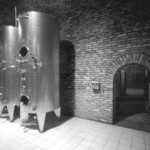To design a vineyard in a traditional, famous vine area, enjoying valuable vernacular architecture, poses three essential problems for architects: to insert the new building within the traditional architecture of the area, to seek new ways of expression of modern, industrial technology of producing wine, or to start from scratch, from the mythical, sacred connotations of wine. A well-documented inquiry will bring valuable international examples to light.
The idea of Konyari Vineyard is quite simple, and consists in the pursuit of ideal relationship to landscape.
Starting from the assumption of the commissioner’s choice of making wine by gravitational technology, a sloped location was necessary. The designers developed the functional requirement and an extremely interesting image was reached: most of the building is hidden underground, while the building on the ground is a natural extension of the hill itself.
The building made of bricks taken from demolished buildings is perfectly integrated in the mild landscape with vines and is also eye-catching. The use of building materials follows the character of traditional agricultural constructions and pays due homage to the architectural context.
However, the architectural and volumetric line of the building is different: its shape is quite unusual, yet honest, and the breaking of the sloped roof leads to minimum heights for the technological process. The essential quality of the design consists in the use of the buttressing stonewall and counterfeit brick, which happily put the last touches on the aesthetics of the landscape. The building has its own perspective, quality, and elegance, reaching a happy balance between tradition and innovation, and pays the due respect towards the site, and individuality. Although it looks modern, it seems to have been there for ages. The building resembles a bit with Janaky Istvan and U. Nagy Gabor’s style, but no more than a whiff of grapes in the wine.
“The more models you can find in a place – in a room, a building, or a town – the livelier the place can get. It becomes more radiant and resembles an inextinguishable flame. This undying flame encapsulates its own anonymous character. When a building is wrapped by this flame it becomes a part of nature. Just like ocean waves or blades of grass, the infinite variety and play of repetition guide the ephemeral.” (Christopher Alexander, The Timeless Road to Building, in: Measurable and Immeasurable, Typotex, Budapest, 2000, pp. 219-220).
The Konyari Vineyard prides in the Sigillum Loliense wine (The Seal of Lelle), a cuvee of Cabernet Sauvignon and Merlot, with the 1760 seal of Lelle. On this first seal you can see a vine and vine prop. Today, the seal perfectly expresses with much dignity the way in which the viticulturist and architect pay due homage to landscape and history through their work.
Design: 2001-2002
Execution: 2002-2003
Architects: Kalmar Laszlo, Zsuffa Zsolt
Collaborator: Varadi Peter
Structure: Harsanyi Csaba (Statiker Kft), Marton Attila
Builder: Steiner Dezso
(Origo Ingatlan Bt)





